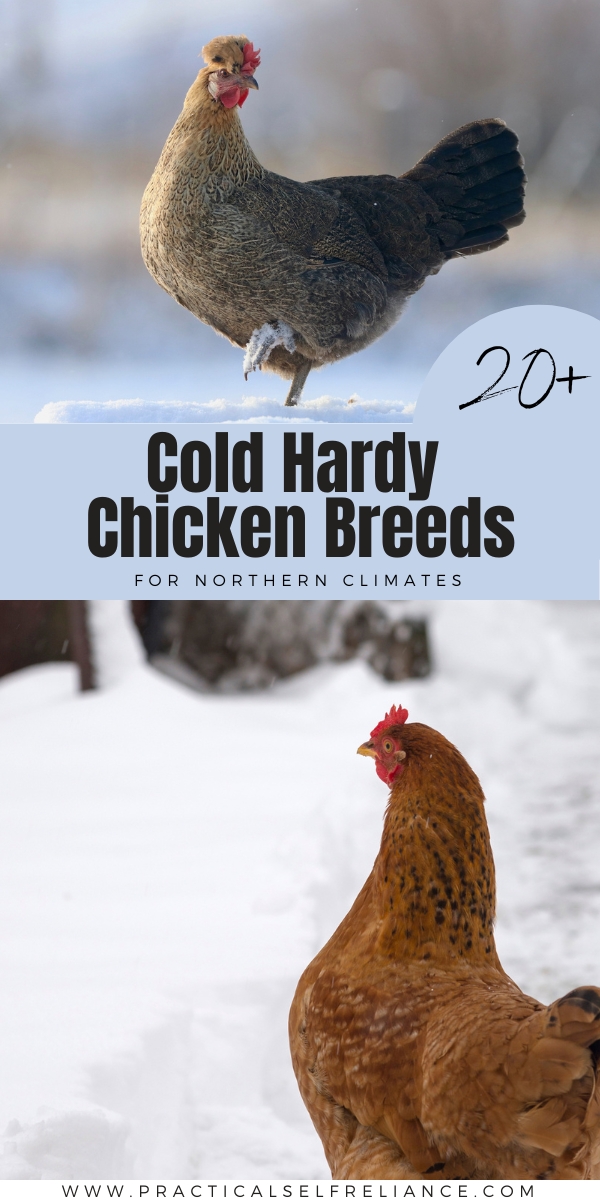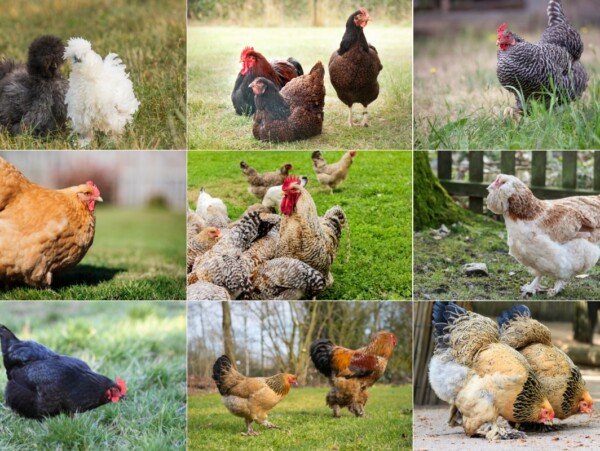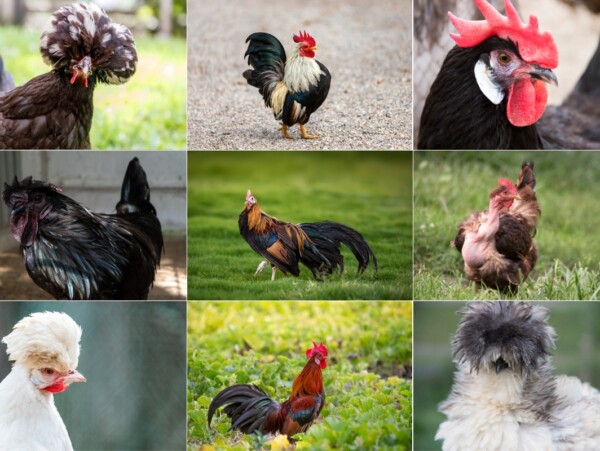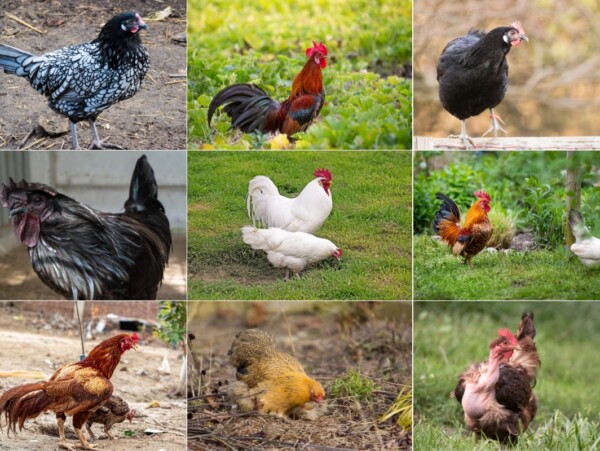Affiliate disclosure: This post may contain affiliate links. Please see our Privacy Policy.
Cold hardy chicken breeds are the absolute best choices for northern climates, and anywhere that sees cold winter temperatures or significant snowfall.

This article is written by Rea Yoh, a freelance writer who grew up in rural Illinois, raising backyard chickens. She graduated with honors in Biology and Science, Technology, and Society from Brown University, and her background in research helps her get to the heart of any question. She has a passion for animals, the environment, and sustainable living.
Some parts of the country can get pretty darn cold. This makes for cozy indoor holidays for you and your family, but what about animals? If you want to raise backyard chickens but have hesitations because of how frosty it can get, don’t worry! There are plenty of chicken breeds that can tolerate the cold, and I’ll introduce them to you.
There are a few characteristics that make these breeds of chicken better in the cold: comb size, body size, and feathering.
First, having a small comb will prevent frostbite up top, so pea combs, walnut combs, and single combs will do better in the cold.
Second, a large chicken will do much better in the cold than a small chicken. Larger body size and more muscle mass correlate to higher metabolism and less heat loss. In the wild, animals living in cold climates have larger body masses than warm climates; according to Bergmann’s rule, a smaller surface area to volume ratio means the animal radiates less body heat.
Third, chickens with dense, hard plumage are more cold-tolerant (so not Silkies!). Some people think that chickens with feathers on their feet are more cold-hardy, and this is true to some degree, as feathers are naturally warm. However, frostbite is still completely possible for chickens with fluffy feet.
If the bedding in the coop isn’t kept dry, feathered feet can actually be a hindrance as they’ll get wet and keep moisture around the feet, potentially leading to cold injury or frostbite.
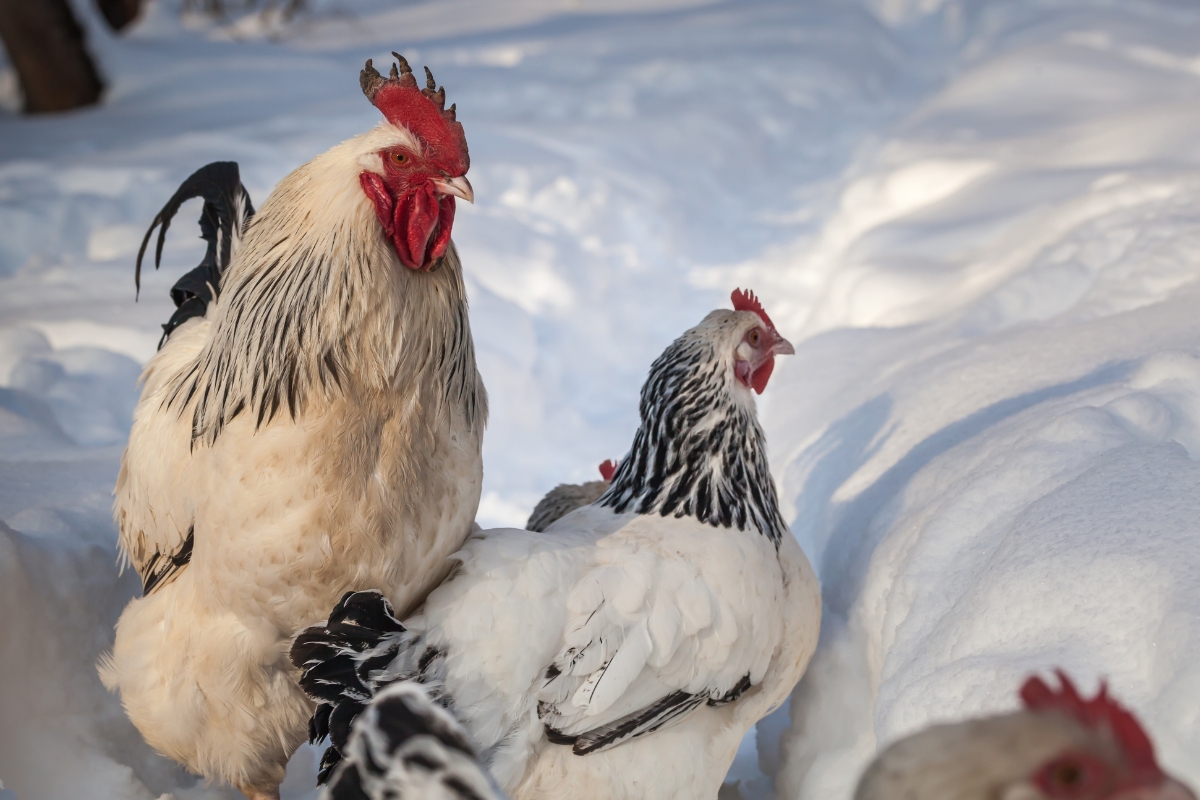
Keeping Chickens in Cold Weather
Are you considering owning chickens and live in a cold climate? Here are a few tips for keeping chickens in cold weather.
First, the coop: make sure the coop is built on ground that is high and dry. Frostbite is a killer during the winter months, and it can get worse if the chicken is in a damp environment. While most chickens can handle a bit of cold, it’s the drafts that get them. Make sure that your coop is properly insulated so that no wind or cold air can get in.
If it gets to freezing temperature, having heating of some kind, whether that be brooder plates, hanging heaters, or panels, will be helpful…but only if it’s consistent. Keeping the ladies toasty warm one day, and then turning it off the next can actually have the opposite effect as temperature swings are harder to adjust to than just steady cold.
Also, make sure that their drinking water won’t freeze by investing in a heated water bowl, or by replacing the water regularly with fresh warm water (but not scalding hot water, obviously).
To prevent frostbite in chickens, you can apply petroleum jelly (like the stuff you use for your skin) to their combs and wattles. Or, better yet, choose chickens with smaller combs, as they can better maintain their combs in cold weather.
Best Cold Hardy Chicken Breeds
If you’re looking for chickens that are easy to keep in the cold (and will also warm your heart!), here are the best cold hardy chicken breeds:
- Ameraucana
- Appenzeller Spitzhauben
- Australorp
- Brahma
- Buckeye
- Chantecler
- Cochin
- Delaware
- Dominique
- Faverolles
- Icelandic
- Jersey Giant
- Marans
- New Hampshire Red
- Norwegian Jaerhon
- Orpington
- Rhode Island Red
- Russian Orloff
- Sussex
- Welsummer
- Wyandotte
Most of these cold, hardy chicken breeds are large-bodied breeds developed in cold regions of the world (such as Germany, Norway, Iceland, Canada, and the Northeastern US). They tend to be dual-purpose breeds, raised for both meat and eggs. Lastly, most are slow-maturing heritage breeds that take between 20 and 35 weeks to reach egg-laying maturity (as compared to 16 to 18 weeks for modern high-production commercial hens).
As a whole, cold hardy chickens are usually calm, docile, friendly, and good foragers.
Most, but not all of the cold hardy breeds have those characteristics in common. There are a few outliers, such as Ameraucanas which are from South America (though at high altitude) and they have a relatively small body size and active disposition.
Each cold hardy chicken breed is described in detail below, to help you choose the best chicken breed for your particular needs.
Ameraucana
One of the few breeds that lay blue eggs, Ameraucanas are treasured for their laying capabilities. Ameraucanas are surprisingly cold hardy, due to their thick feathering and small peacombs, which are less likely to freeze. Throughout the winter, you can expect your chickens to continue producing those pretty blue eggs, as long as they have the light and resources to do so.
Besides their eggs, you might want to keep an Ameraucana for how agreeable this breed is. They are intelligent, curious, and enjoy the company of people.
Here’s where you can find my full Ameraucana Chicken Breed Guide.
- Breed Name: Ameraucana (uh-mer-uh-can-uhh)
- Breed Type: All other layer
- Temperament: Curious, docile, good foragers
- Size: Hens 5.5 lbs, Roosters 6.5 lbs.
- Eggs Per Year: 150-200
- Egg Size: Medium
- Egg Color: Blue, with occasional green tints
- Feather Type: Standard, with trim muffs and clean legs
- Comb Type: Pea Comb
- Hardiness: Cold Hardy and Heat Tolerant
- Lifespan: 7-8 years
- Time To Maturity: 20 to 24 Weeks
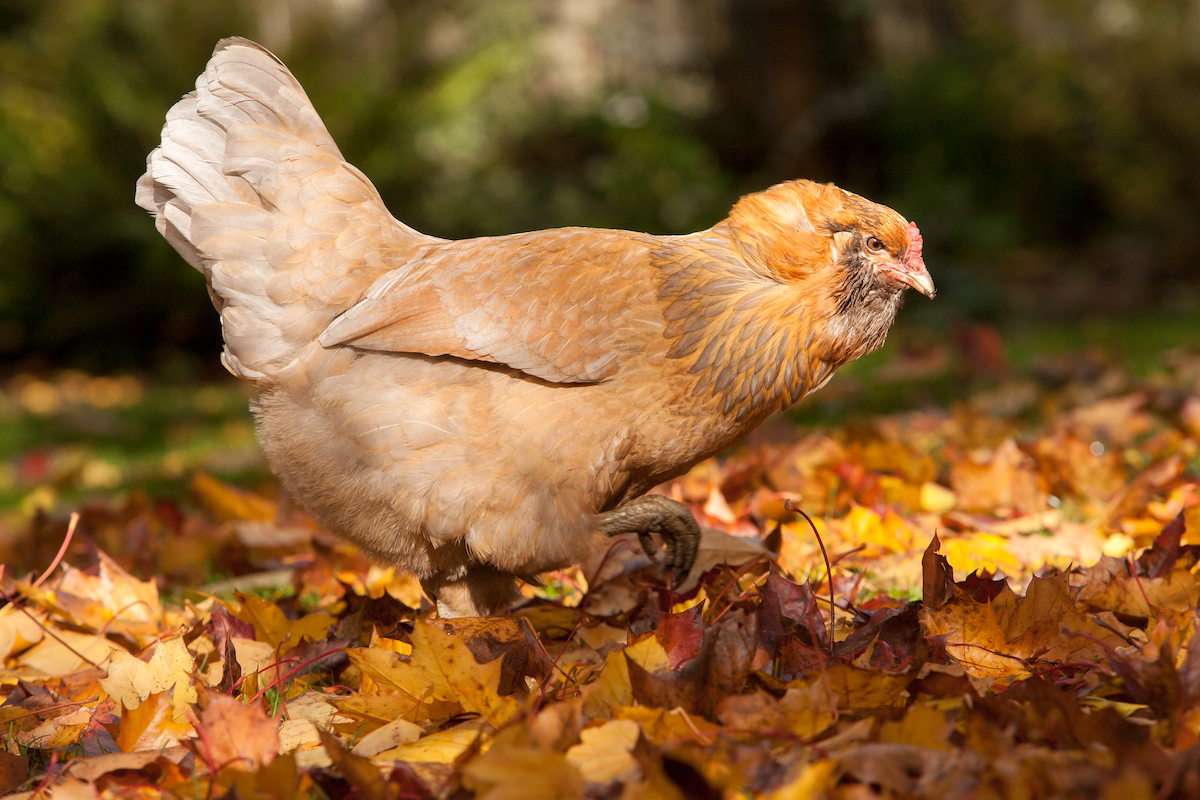
Appenzeller Spitzhauben
The Spitzhauben is a lesser-known breed that was developed in the mountains of Switzerland, living in Swiss monasteries and laying eggs. Although the Spitzhauben isn’t recognized by the APA, there have been efforts to standardize this breed. These birds are amazing foragers and will weather through the cold easily. Spitzhauben are active chickens that have a lot of energy.
They’re highly alert to their surroundings and will let their flockmates know of danger immediately, making them well-suited for free-roaming. They don’t like confinement very much and prefer to stretch their wings and fly. The Spitzhauben is a rare breed that isn’t found often in many backyards, but that’s changing.
- Breed Name: Appenzeller Spitzhauben (app-uhn-zell-urr spits-haw-ben)
- Breed Type: Layer
- Temperament: Flighty, excited, active
- Size: Hens 3.5 lbs, roosters 4.5 lbs
- Eggs Per Year: 150-180
- Egg Size: Medium to large
- Egg Color: White or tinted
- Feather Type: Standard, clean legs
- Comb Type: V-comb
- Hardiness: Cold hardy
- Lifespan: 5+ years
- Time To Maturity: 20-22 weeks
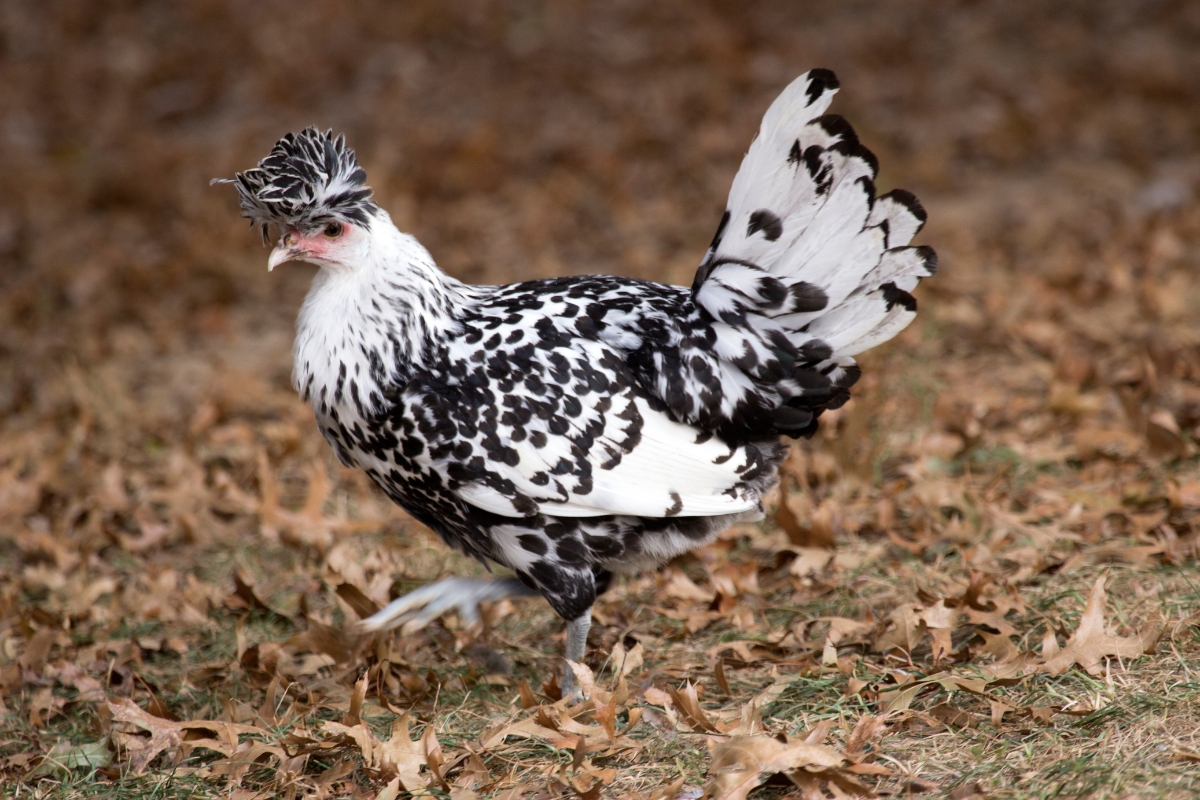
Australorp
An Australian take on the Orpington, the Australorp takes all of the qualities of its predecessor and puts them into one gorgeous package. These cold-hardy birds are able to withstand cold climates. Australorps are dual-purpose birds, used for both meat and eggs.
Apparently, the record for the highest number of eggs produced by a hen in a year goes to an Australorp! They’re known to lay during the winter, although their production might decrease a bit.
- Breed Name: Australorp
- Breed Type: English, dual-purpose (meat and eggs)
- Temperament: Calm, easygoing, gentle
- Size: Hens 6 lbs, roosters 10 lbs
- Eggs Per Year: 250-300
- Egg Size: Large
- Egg Color: Light brown
- Feather Type: Standard, clean legs
- Comb Type: Single
- Hardiness: Cold hardy and heat tolerant
- Lifespan: 8+ years
- Time To Maturity: 20-22 weeks
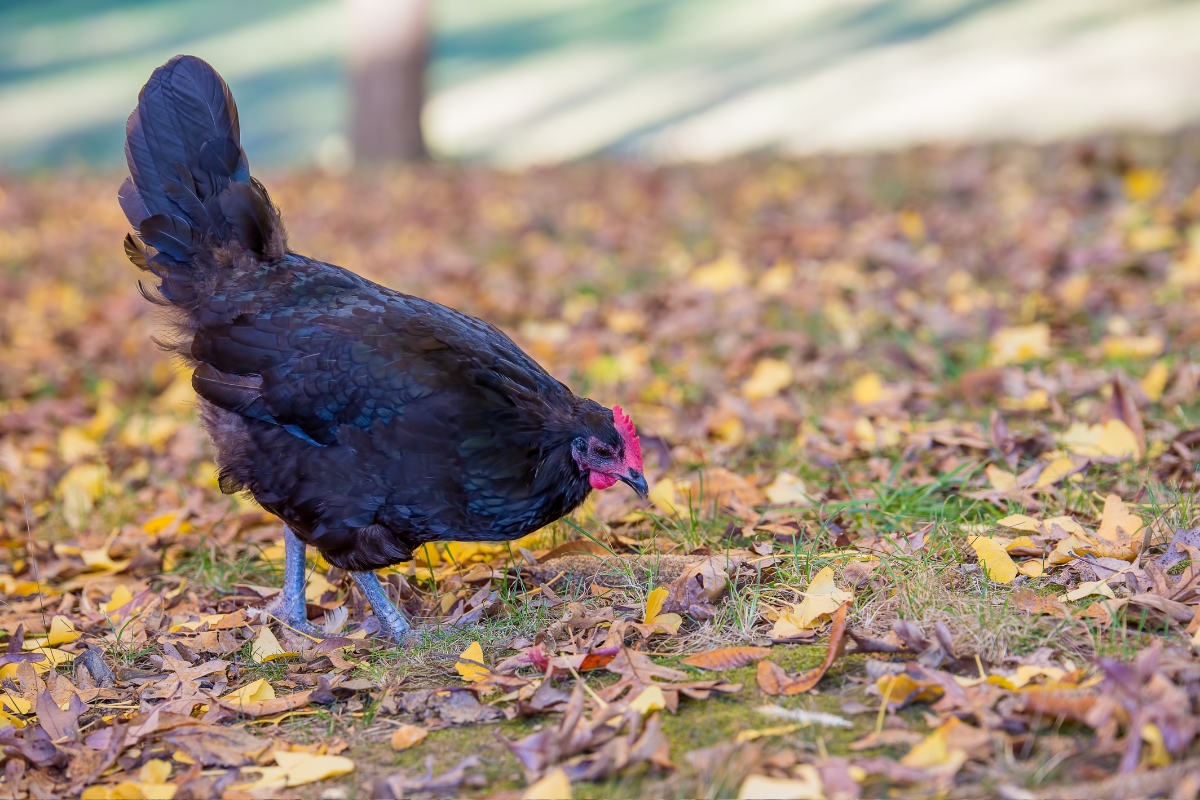
Brahma
One of the largest breeds of chicken is the Brahma. These chickens are covered from head to toe with thick, dense feathers, and their body size makes it easy for them to stay warm, especially when they have other Brahmas to huddle with. The feathered legs can be a double-edged sword–while they are effective at keeping a Brahma’s legs warm, if their legs get wet, this could result in frostbite.
Make sure that your Brahma has a nice, dry place to stay during the cold, and you’ll find that these birds are perfectly happy.
Here’s where you can find my full Brahma Chicken Breed Guide.
- Breed Name: Brahma
- Breed type: Asiatic, dual-purpose (meat and eggs)
- Temperament: Laid-back, docile, confident
- Size: Roosters 10 lbs; Hens 8 lbs.
- Eggs Per Year: 150-200
- Egg Size: Medium
- Egg Color: Brown
- Feather Type: Asiatic, feather-legged
- Comb Type: Pea Comb
- Hardiness: Cold hardy
- Lifespan: 5-8 years
- Time To Maturity: 6-7 months for laying, can be used at 8-10 weeks for meat
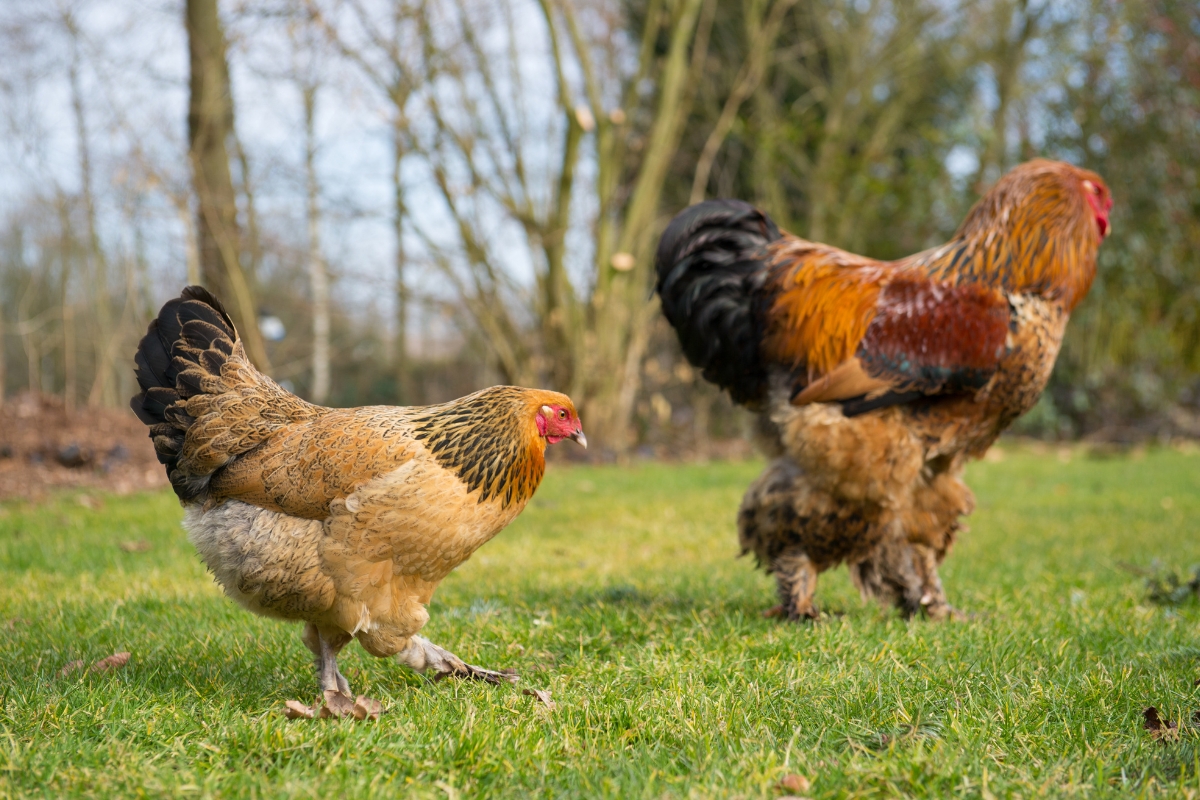
Buckeye
Buckeye chickens were developed in Ohio, the Buckeye State. Buckeyes are the only breed of chicken developed by a woman, Nettie Metcalf, and are an excellent dual-purpose chicken. Their large body size produces very tender meat, and some strains of Buckeye produce up to 250 eggs per year!
Their body mass and small pea combs mean that the Buckeye is very cold hardy. Buckeyes are very active birds that do best in free range–they’re amazing foragers and will catch mice!
- Breed Name: Buckeye
- Breed Type: American, dual-purpose
- Temperament: Active, curious, bold
- Size: Hens 6.5 lbs, roosters 9 lbs
- Eggs Per Year: 150-250
- Egg Size: Large
- Egg Color: Brown
- Feather Type: Standard, clean legs
- Comb Type: Pea comb
- Hardiness: Cold hardy
- Lifespan: 10+ years
- Time To Maturity: 30-32 weeks

Chantecler
Developed to survive the harsh Canadian winters, the Chantecler is a relatively rare breed that does well in cold weather. The Chantecler has one of the tiniest combs, a itty-bitty cushion comb, and practically no wattle, so frostbite isn’t a concern. They’re also big birds that like flocking together to stay warm.
In terms of personality, Chanteclers are very gentle and get along easily with people and other chickens. They do well in free range or confinement.
- Breed Name: Chantecler (shahnt-clair)
- Breed Type: American, dual purpose (meat and eggs)
- Temperament: Intelligent, gentle, calm
- Size: Hens 6.5, roosters 9 lbs
- Eggs Per Year: 200-240
- Egg Size: Medium to large
- Egg Color: Brown
- Feather Type: Standard, clean legs
- Comb Type: Cushion
- Hardiness: Very cold hardy
- Lifespan: 8+ years
- Time To Maturity: 24-30 weeks

Cochin
Cochins are large, heavy chickens that are well-suited for the cold because of their size and feathering. Their legs are covered in feathers, which protect them from the cold. However, like other feather-legged breeds, Cochins are prone to getting frostbite in wet conditions, making a dry coop and roost very important during the cold months.
Because they’re so big, Cochins are very confident and easygoing, especially with their people. You’ll enjoy the company of a Cochin, as well as the very respectable number of eggs it produces.
- Breed Name: Cochin
- Breed Type: Asiatic, dual-purpose (meat and eggs), exhibition
- Temperament: Cuddly, loving, affectionate
- Size: Rooster 11 lbs, hen 8.5 lbs
- Eggs Per Year: 150-180
- Egg Size: Large
- Egg Color: Brown
- Feather Type: Asiatic, feather-legged
- Comb Type: Single
- Hardiness: Cold-hardy
- Lifespan: 8-10 years
- Time To Maturity: 8 months (eggs), 4-16 months (meat)
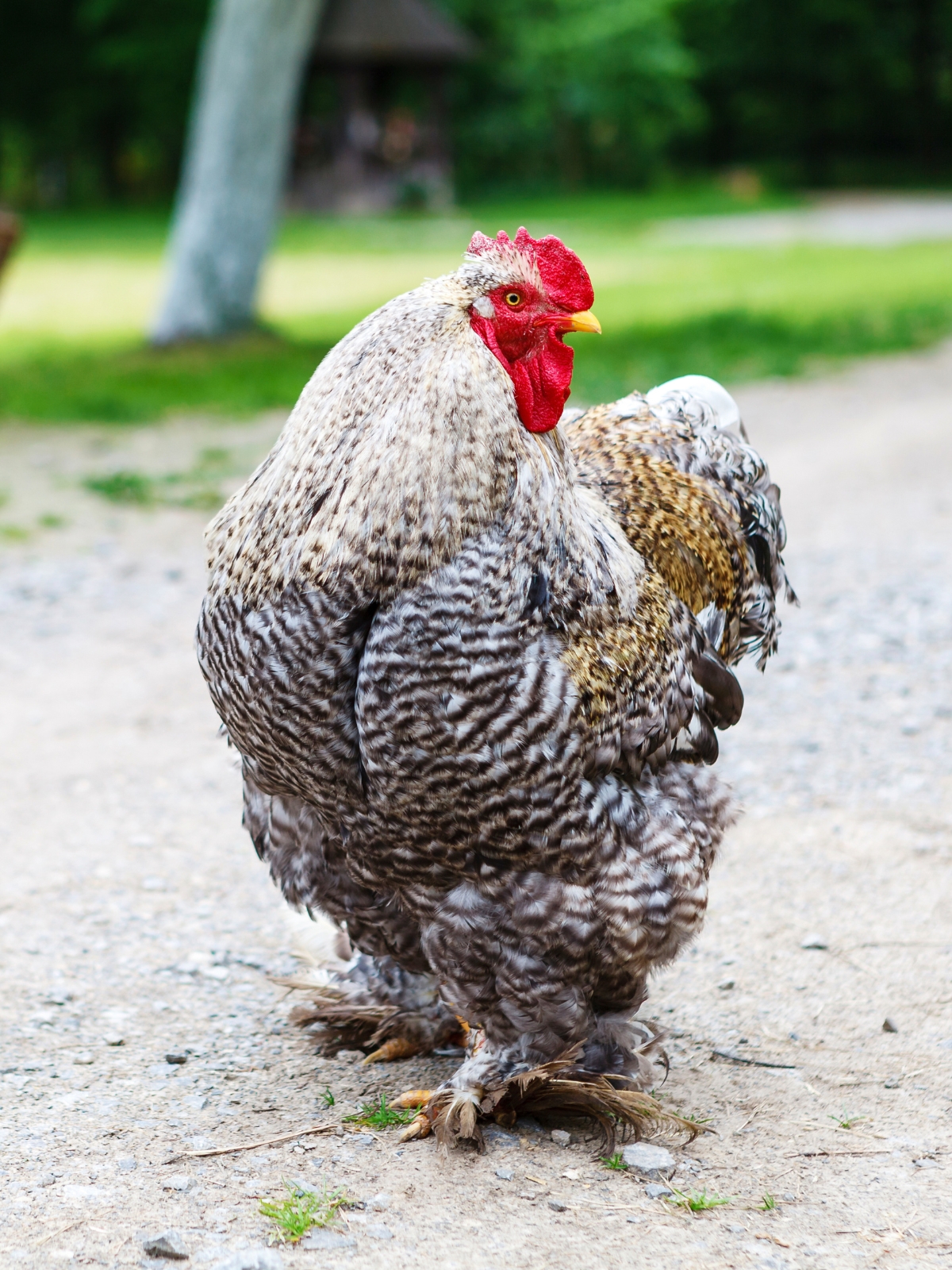
Delaware
Once one of the best-known broiler breeds, the Delaware is a big chicken with a big personality. A Delaware chicken’s size makes it well-suited to raise in cold climates, as they are very cold-hardy birds. Delawares are low-maintenance birds that do well in confinement or free range. Delawares lay about 150-200 jumbo eggs per year, and they’re fine with laying as the months get colder.
For the coldest of times, putting some vaseline on the combs of the roosters will help prevent frostbite. Delawares are very alert, active, and predator-savvy. They’re quite friendly towards people, as well, making them a great choice for families.
- Breed Name: Delaware
- Breed Type: American, dual-purpose (meat and eggs)
- Temperament: Active, lively, friendly
- Size: Hens 6 lbs, roosters 8 lbs
- Eggs Per Year: 150-200
- Egg Size: Large
- Egg Color: Light brown
- Feather Type: Standard, clean legs
- Comb Type: Single
- Hardiness: Cold hardy
- Lifespan: 5+ years
- Time To Maturity: 18-20 weeks
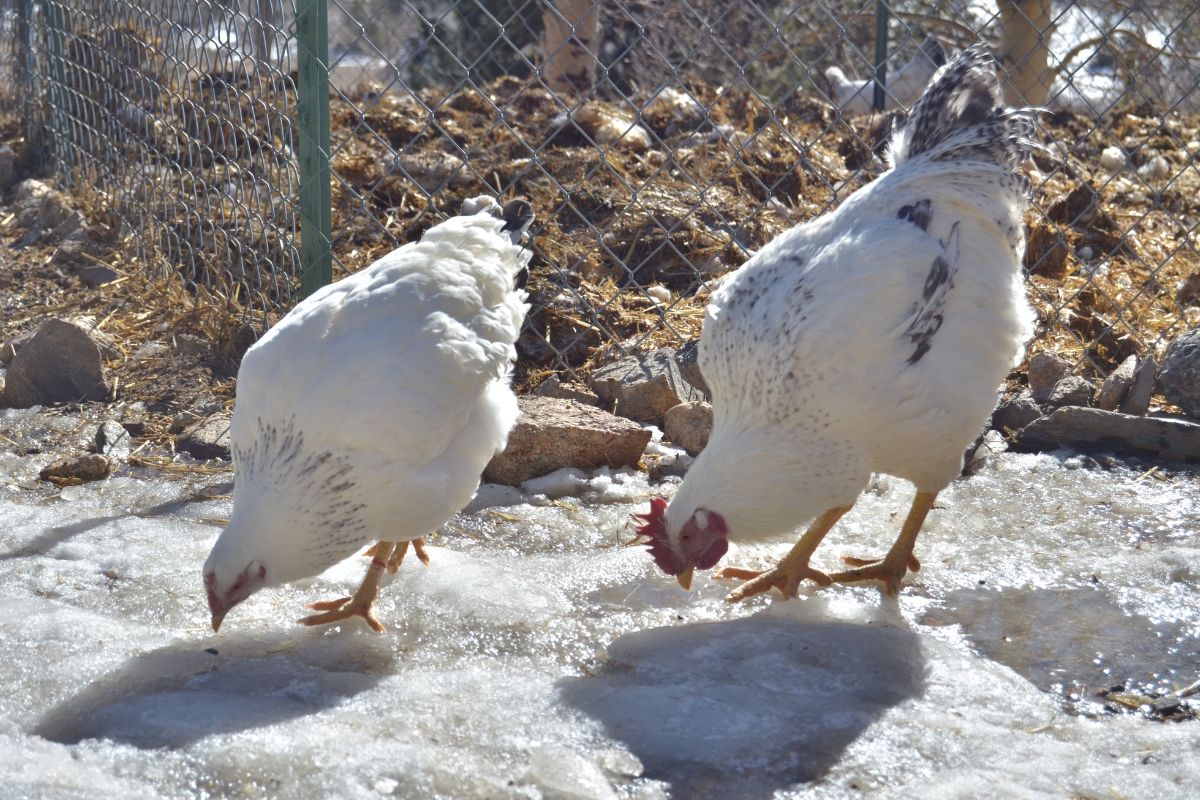
Dominique
America’s oldest chicken breed, the Dominique, is known for its extreme hardiness. They’re great for people living in cold climates, mostly because of their rose comb, which doesn’t contract frostbite very easily.
Dominiques are very friendly, especially with people–roosters can be a bit aggressive towards other chickens, but are generally very kind with their owners. Dominiques produce a lot of eggs all year, about four per week, and have a size that makes them good broilers.
- Breed Name: Dominique
- Breed Type: American, dual-purpose (meat and eggs)
- Temperament: Calm, alert
- Size: hens 5 lbs, roosters 7 lbs
- Eggs Per Year: 200-280
- Egg Size: Medium to large
- Egg Color: Light brown
- Feather Type: Standard, clean legs
- Comb Type: Rose comb
- Hardiness: Cold hardy and heat tolerant
- Lifespan: 8+ years
- Time To Maturity: 21-24 weeks
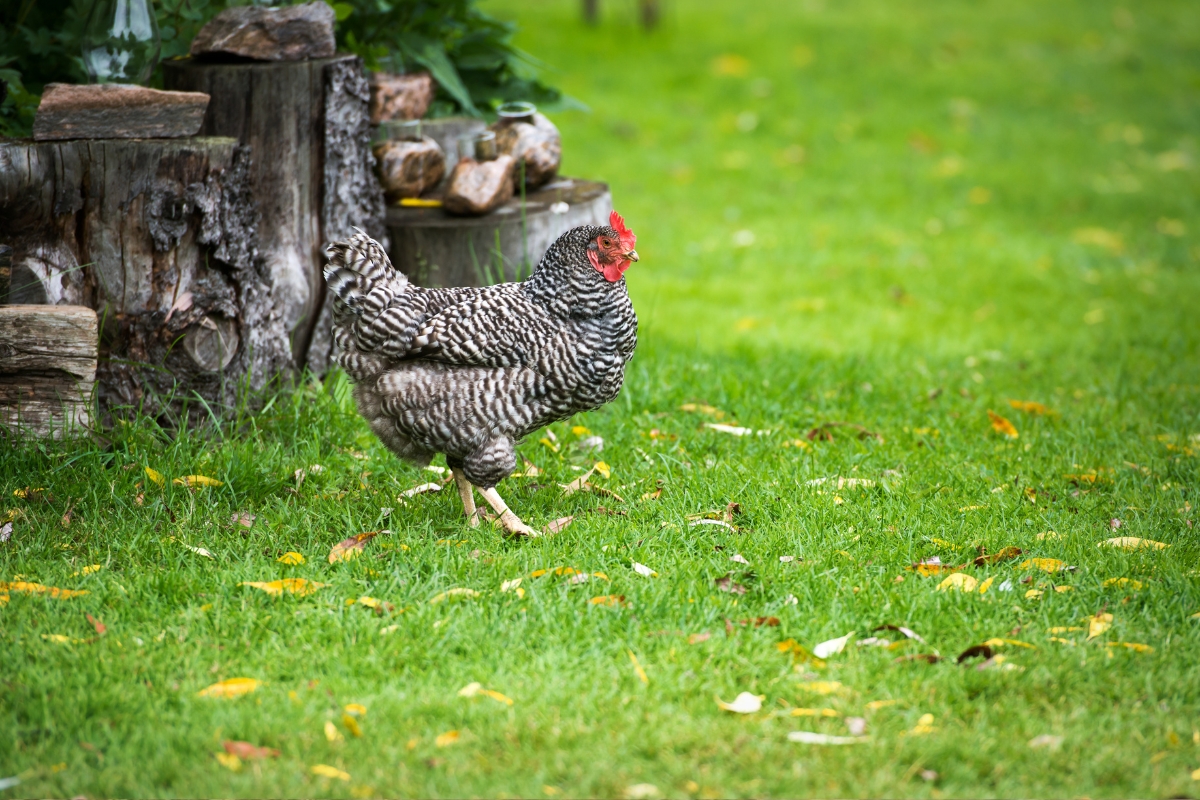
Faverolles
Faverolles are a versatile breed of chicken and very well-suited to the cold. Their fluffy muffs and feathered legs keep them perfectly warm, and they will happily huddle with other chickens to share their warmth. Faverolles lay a large number of cream or white eggs, and they’re large enough to be good meat birds.
Not only are they a hardy dual-purpose breed, but they’re lovely to look at, with soft, puffy feathers all over. Make sure that your Faverolles have a place that is nice and dry so they won’t run into any problems with frostbite.
Here’s where you can find my full Faverolles Chicken Breed Guide.
- Breed Name: Faverolles (fav-roll)
- Breed Type: Ornamental, eggs, meat
- Temperament: Active, friendly, docile
- Size: Roosters 8 lbs, hens 6.5 lbs
- Eggs Per Year: 180-240
- Egg Size: Medium
- Egg Color: Cream, white
- Feather Type: Continental, muffs, feather-legged
- Comb Type: Single
- Hardiness: Heat-tolerant and cold-hardy
- Lifespan: 5-7 years
- Time To Maturity: 19 weeks
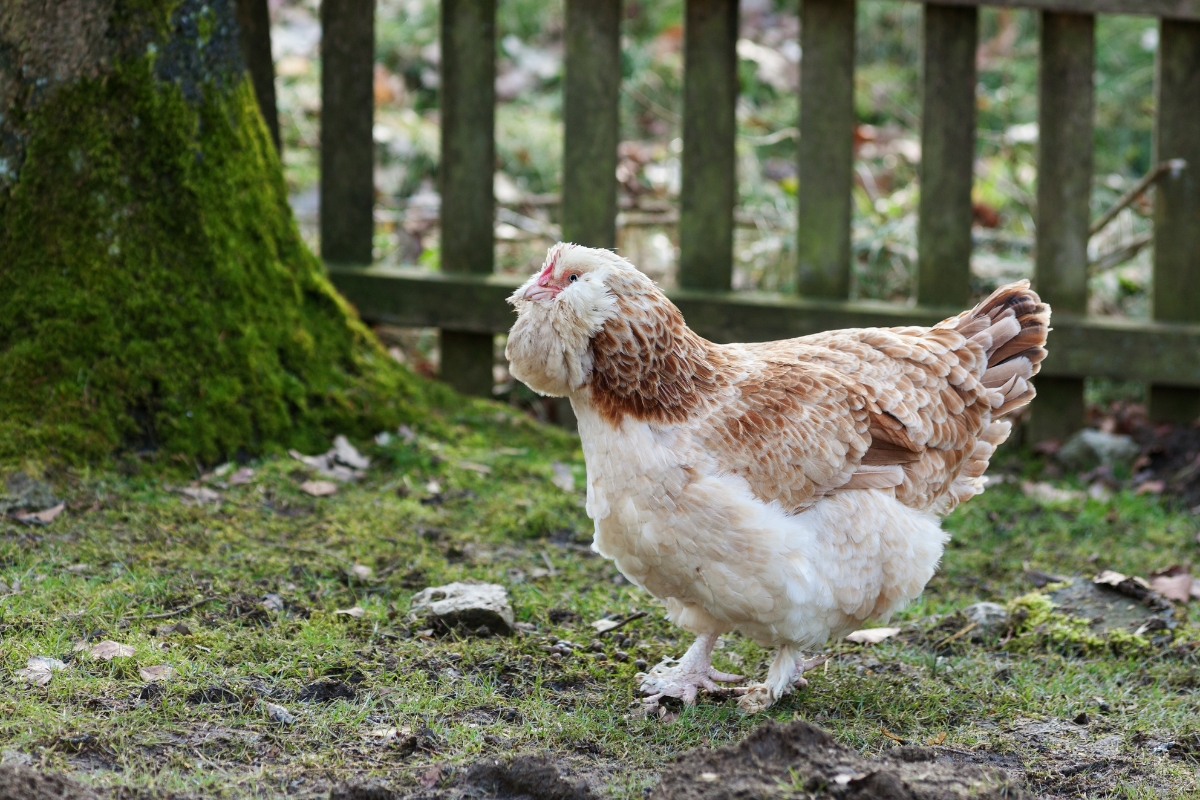
Icelandic
The rare Icelandic was once the only breed of chicken to exist in Iceland, all the way from the 10th century! As landrace chickens, they became well-adapted to the harsh conditions of Iceland. The Icelandic chicken is a robust, hardy breed that does well on its own.
It’s an independent breed of chicken and is very alert to danger, which is great if you want a hands-off chicken that can fend for itself. There isn’t a standard for Icelandic chickens, and you’ll see a variety of combs, all of which are small enough to prevent frostbite.
- Breed Name: Icelandic
- Breed Type: All other, layer
- Temperament: Active, flighty, energetic
- Size: Females 3 lbs, males 5 lbs
- Eggs Per Year: 180
- Egg Size: Medium
- Egg Color: Light brown, white, cream
- Feather Type: Standard, clean legs
- Comb Type: Varies (rose, single, pea all possible)
- Hardiness: Very cold hardy, heat tolerant
- Lifespan: 10+ years
- Time To Maturity: 20-22 weeks
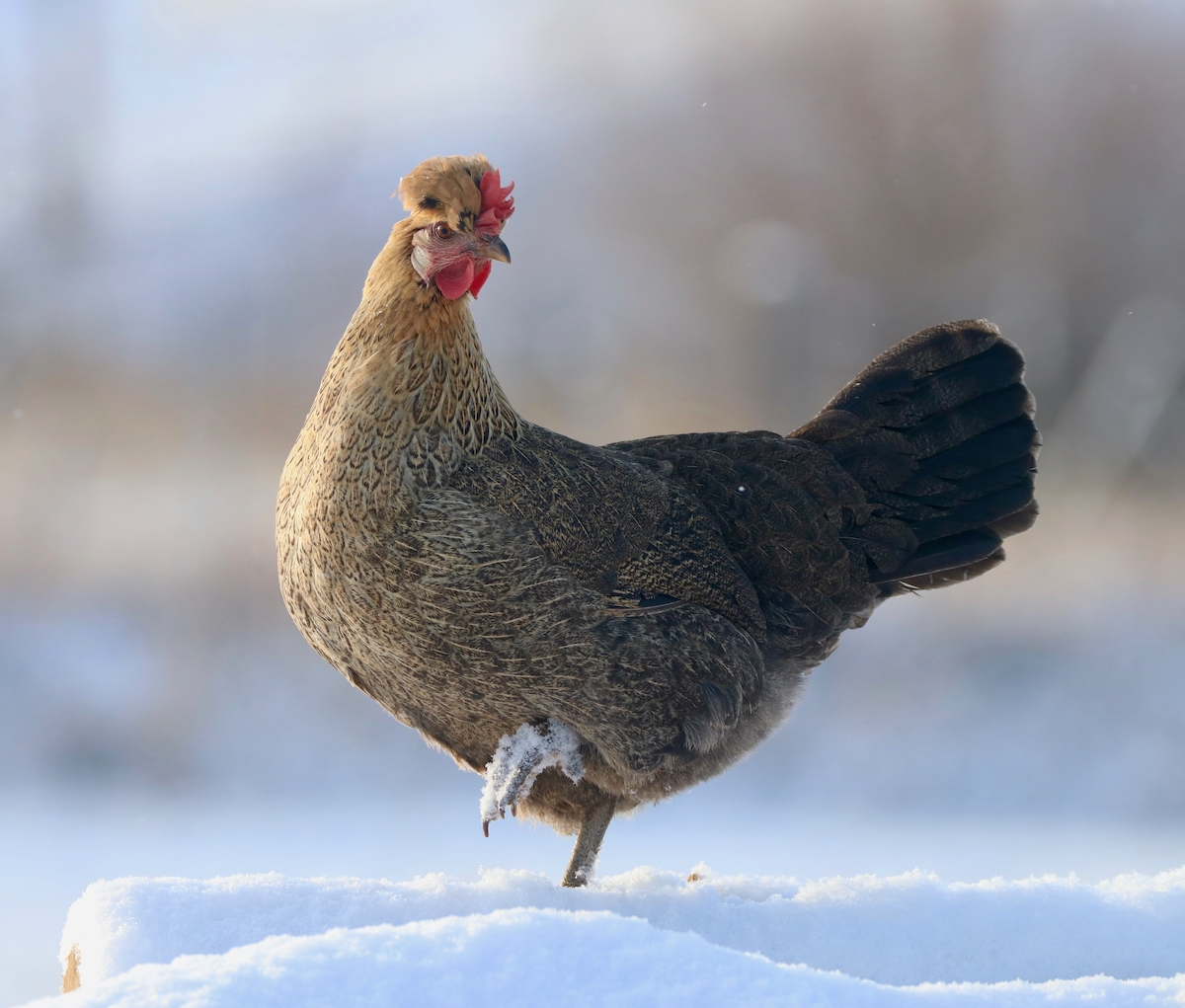
Jersey Giant
The Jersey Giant is aptly named, as it is the largest chicken breed that exists. Naturally, a chicken this large will be great at keeping warm (and they don’t do well in the heat!). Hens aren’t at much risk for frostbite with proper shelter, although the roosters have large combs that might need special treatment.
Jersey Giants aren’t very active birds and therefore do well in confinement with enough space. Despite their relaxed nature, Jersey Giants are certainly a spectacular breed to observe. They have gorgeous black feathers with a beetle-green sheen.
Here’s where you can find my full Jersey Giant Chicken Breed Guide.
- Breed Name: Jersey Giant
- Breed Type: American, dual-purpose (meat and eggs)
- Temperament: Easygoing, calm
- Size: Hens 10 lbs, roosters 13 lbs
- Eggs Per Year: 150-200
- Egg Size: Large
- Egg Color: Brown
- Feather Type: Standard, clean legs
- Comb Type: Single
- Hardiness: Cold hardy
- Lifespan: 6-10 years
- Time To Maturity: 18-20 weeks
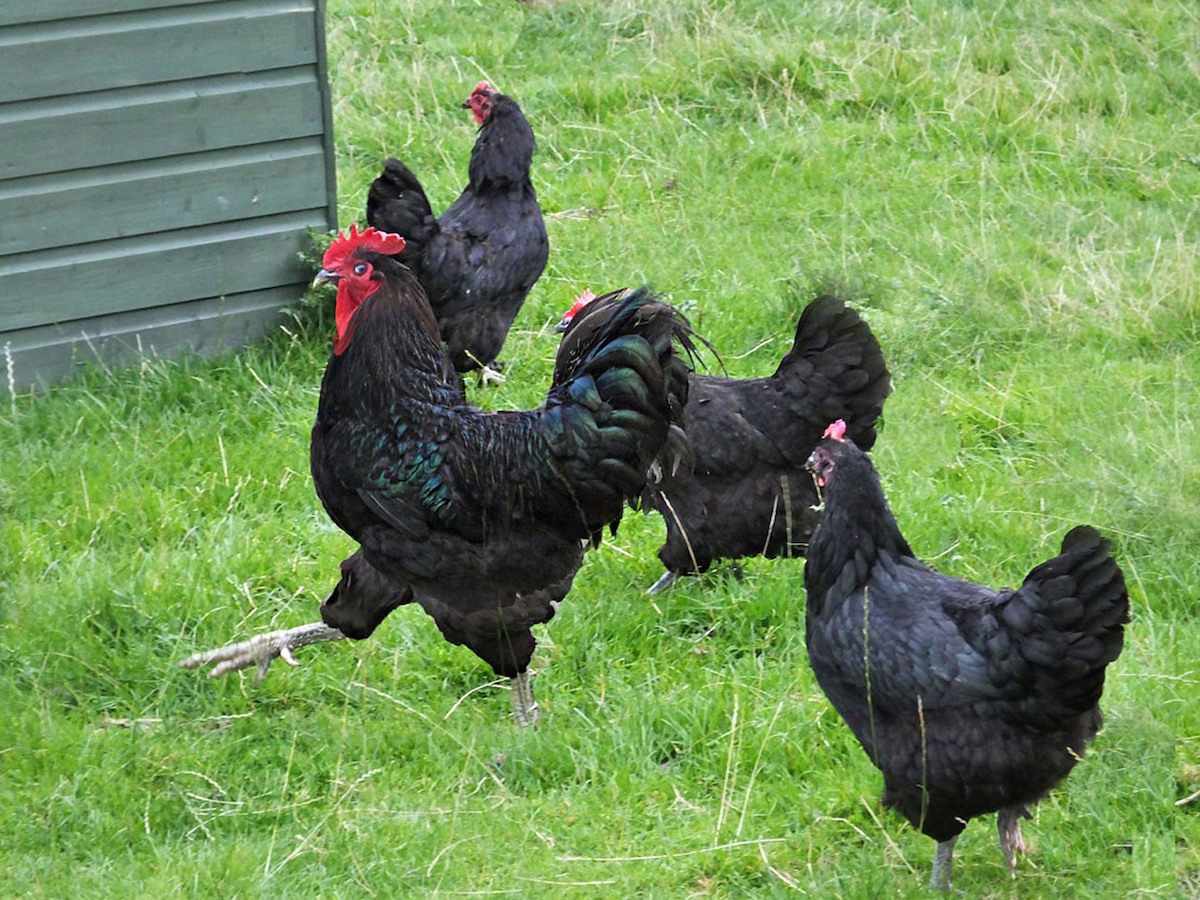
Marans
The Marans is a beautiful, heavy breed of chicken best known for its ability to lay dark brown eggs. Their soft, dense feathers protect them from the cold. Some varieties of Marans have feathers on their feet, which need to be dried to prevent frostbite.
Marans see a decrease in egg production during the coldest months, but this is common to most breeds of chicken–they need to conserve their energy! If you want to see beautiful dark brown eggs all year, make sure they have enough food and light.
Here’s where you can find my full Marans Breed Guide.
- Name: Marans
- Breed Type: Continental, dual-purpose (meat and eggs)
- Temperament: Friendly, gentle
- Size: hens 6 lbs, roosters 8 lbs
- Eggs Per Year: 150-200
- Egg Size: Large
- Egg Color: Dark brown
- Feather Type: Standard, with trim muffs and clean legs
- Comb Type: Single
- Hardiness: Cold hardy and heat tolerant
- Lifespan: 7-8 years
- Time To Maturity: 20 to 24 Weeks
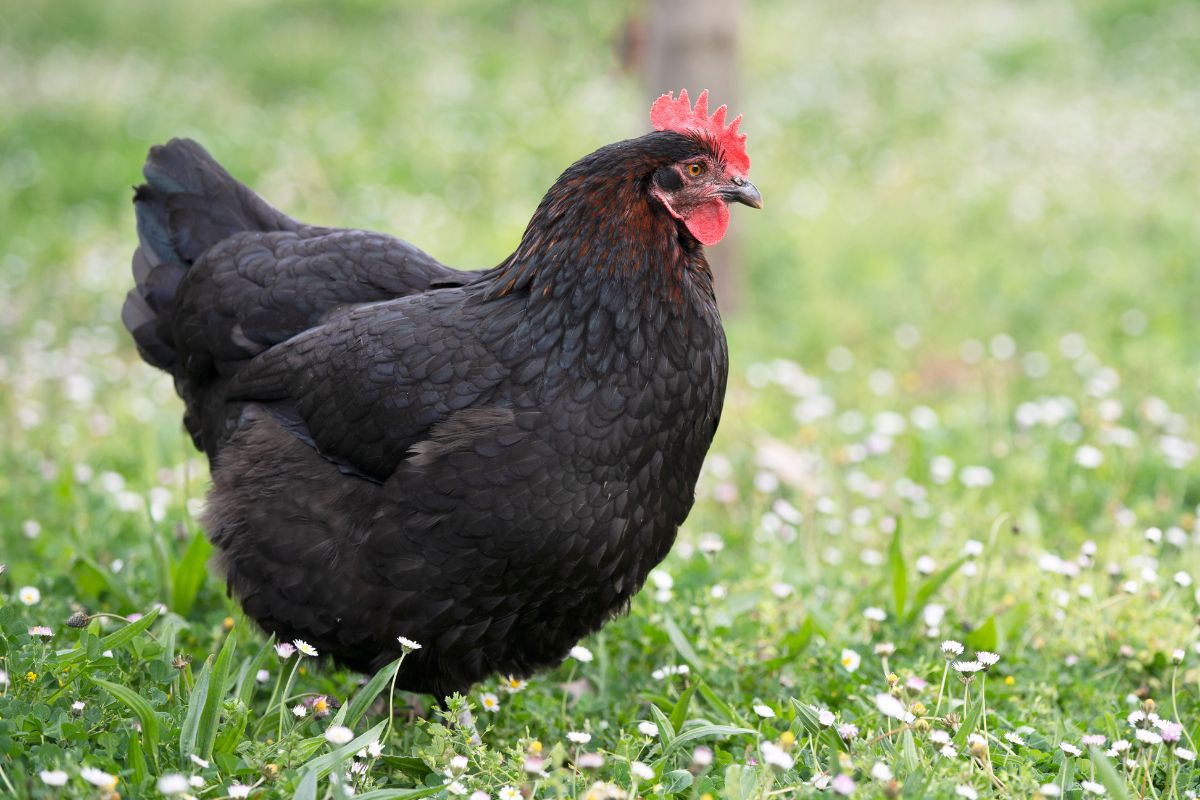
New Hampshire Red
New Hampshire Reds are often overlooked for the Rhode Island Red, and they do look quite similar, with lovely red feathers and wattles. The New Hampshire Red is just as good as its cousin in the egg laying and meat-producing ring.
It’s not a surprise that the New Hampshire Red is a cold hardy chicken breed, as it was bred to survive the harsh New England winters. They’re a very friendly breed, easily handled, and happy in both confinement and free range.
- Breed Name: New Hampshire Red
- Breed Type: American, dual-purpose (meat and eggs)
- Temperament: Gentle, docile, friendly
- Size: Hens 6.5 lbs, roosters 8 lbs
- Eggs Per Year: 200-250
- Egg Size: Large
- Egg Color: Brown
- Feather Type: Standard, clean legs
- Comb Type: Single
- Hardiness: Cold hardy and heat tolerant
- Lifespan: 6-8 years
- Time To Maturity: 16-20 weeks
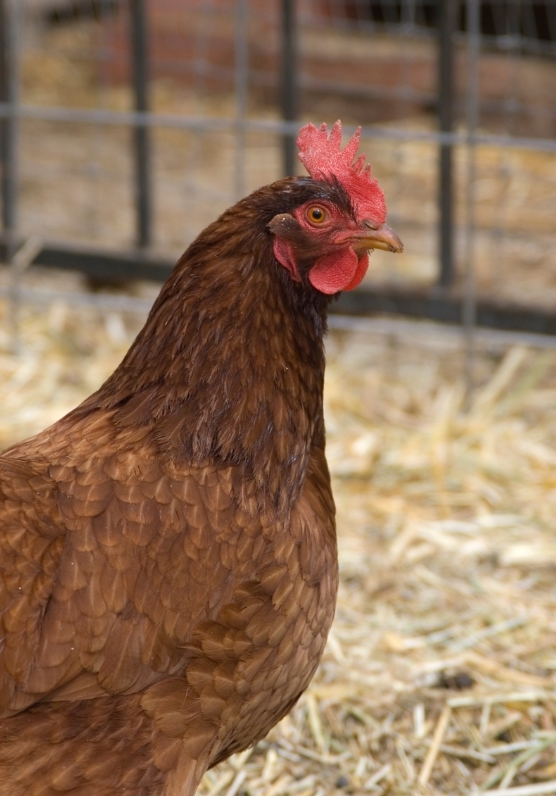
Norwegian Jaerhon
The only breed indigenous to Norway, the Norwegian Jaerhon is no stranger to the cold. These chickens were bred to withstand harsh winters. They’re a compact breed but lay surprisingly large eggs, without a tendency to go broody.
Norwegian Jaerhon hens are great to have if you want to keep egg production high year-round. These chickens are friendly and lively, flitting and flying about in excitement. If you want a cold-hardy heritage breed that’s easy to keep, Norwegian Jaerhon is the way to go.
- Breed Name: Norwegian Jaerhon (Yarr-hon)
- Breed Type: Layer
- Temperament: Active, energetic, friendly
- Size: Hens 3 lbs, roosters 5 lbs
- Eggs Per Year: 200-250
- Egg Size: Large
- Egg Color: White or tinted
- Feather Type: Standard, clean legs
- Comb Type: Single
- Hardiness: Cold hardy and heat tolerant
- Lifespan: 5+ years
- Time To Maturity: 20-22 weeks
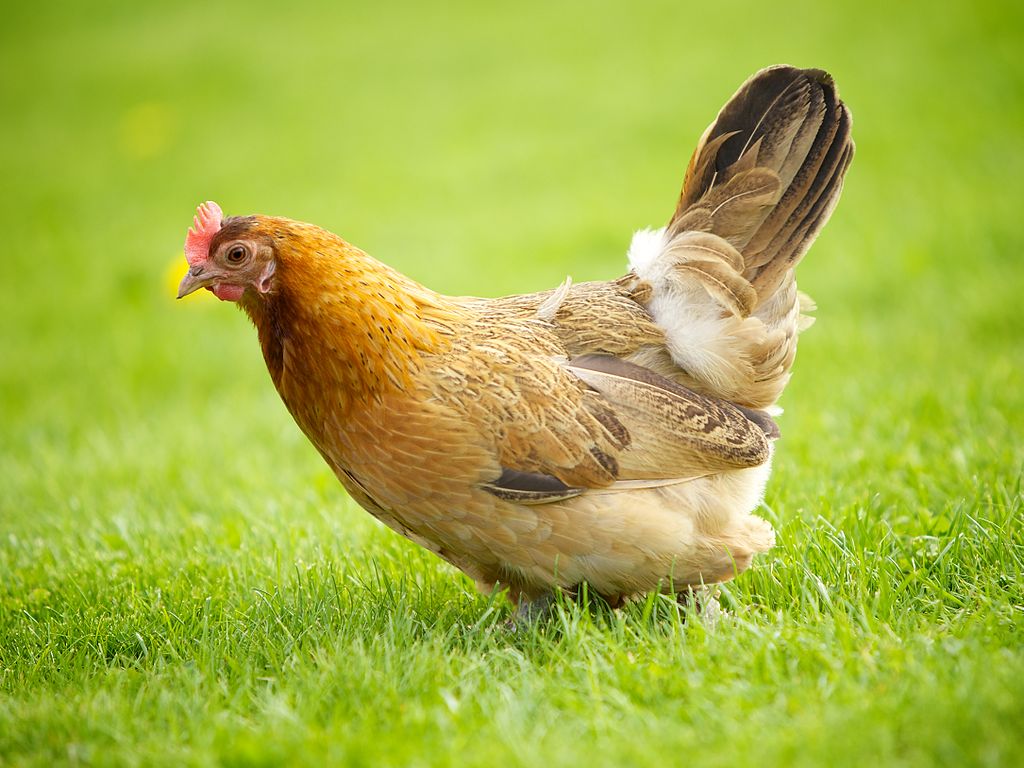
Orpington
For beginners or chicken veterans, for hot or cold climates, for egg lovers, meat eaters, or people who love the idea of having a feathery friend, the Orpington is everything. There are countless reasons why the Orpington is one of the most popular breeds of chicken.
This backyard staple is a heavy dual-purpose breed that is covered in soft, warm feathers, making it perfect for withstanding the cold. Soft in both plumage and in personality, Orpingtons are very sweet chickens that make excellent pets.
Here’s where you can find my full Orpington Chicken Breed Guide.
- Breed Name: Orpington
- Breed Type: English, dual-purpose (meat and eggs)
- Temperament:
- Size: Hen 8 lbs, roosters 10 lbs
- Eggs Per Year: 200-280
- Egg Size: Medium to large
- Egg Color: Light brown
- Feather Type: Soft standard, clean legs
- Comb Type: Single
- Hardiness: Cold hardy and heat tolerant
- Lifespan: 8+ years
- Time To Maturity: 20-22 weeks
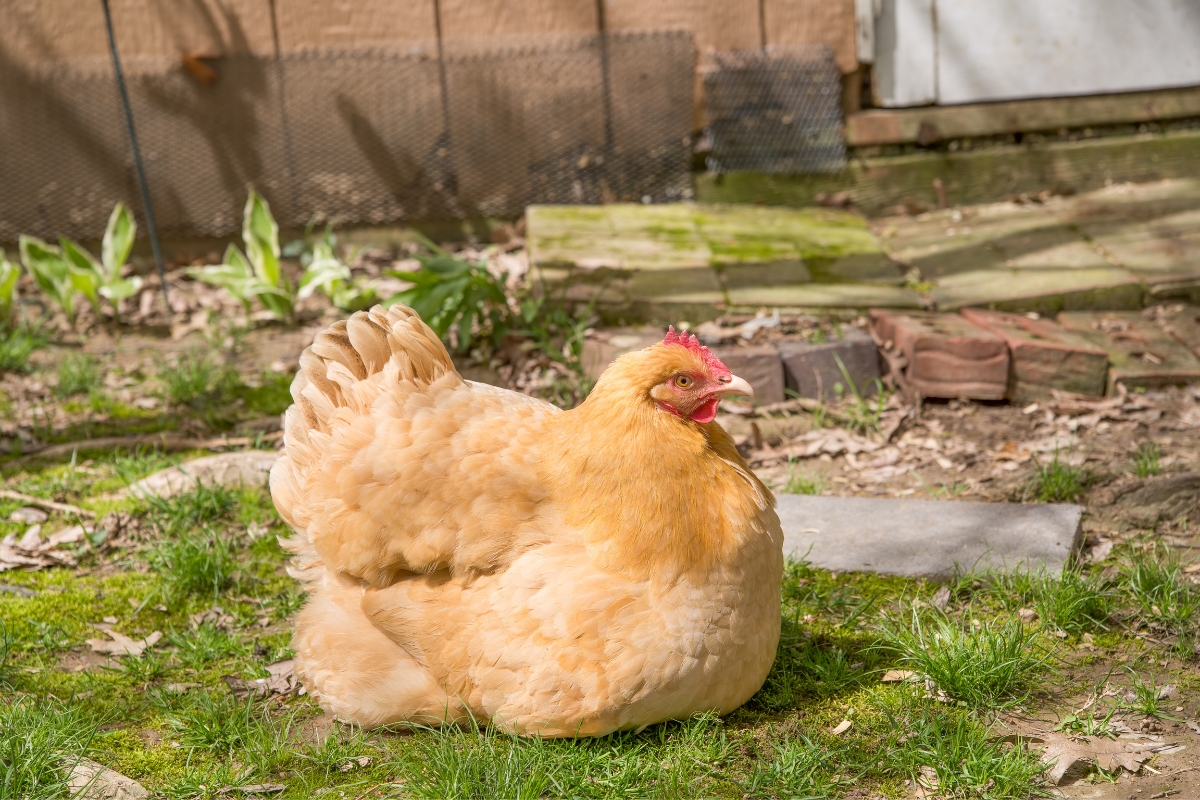
Rhode Island Red
One of the champions of the egg industry, the Rhode Island Red is a breed that is happy to lay all year round, even in the cold. Winters in Rhode Island can be harsh–it’s usually 20 degrees (or colder), with plenty of snow, ice, and wind. It isn’t a surprise that a chicken breed developed in such a frosty state would be cold hardy. One of the biggest reasons people keep Rhode Island Reds is their extreme productivity, laying up to 300 eggs per year.
They’re also big enough to be used as table birds. Rhodies, personality-wise, are very active and lively, some might even say to the point of being aggressive with chicken breeds that are a bit more shy. Nevertheless, Rhode Island Reds are an excellent cold-hardy breed of chicken to have, especially if you love eggs.
- Breed Name: Rhode Island Red
- Breed Type: Dual purpose (meat and eggs)
- Temperament: Curious, alert, active
- Size: Hens 6 lbs, roosters 8 lbs
- Eggs Per Year: Up to 300
- Egg Size: Medium to large
- Egg Color: Brown
- Feather Type: Standard, clean legs
- Comb Type: Single Comb
- Hardiness: Cold Hardy and Heat Tolerant
- Lifespan: 5+ years
- Time To Maturity: 16 to 20 Weeks
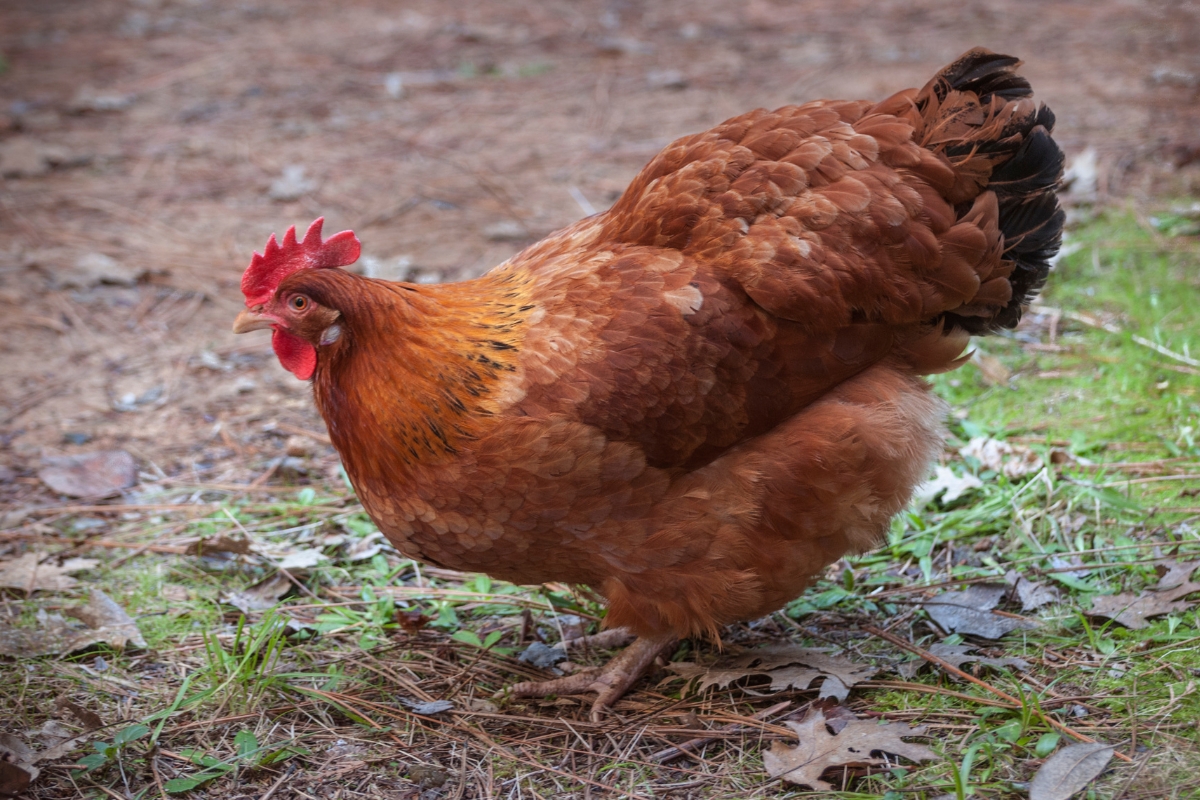
Russian Orloff
The Russian Orloff is a rare breed of chicken. It was once accepted as a breed by the APA, but this status was rescinded due to its lack of popularity. The Russian Orloff is an extremely cold hardy breed that does very well in cold climates, due to the large body size, thick feathers, and tiny cushion comb.
Russian Orloffs are very fluffy looking chickens, but they aren’t very cuddly, preferring to live independently from their people–they’re great foragers and are happy both outside or in confinement. They can get along with most other chickens, although they will not tolerate bullying and will defend themselves. Russian Orloffs are primarily used for meat, although they do have a very slow growth rate.
- Breed Name: Russian Orloff
- Breed Type: Meat
- Temperament: Confident, assertive, independent
- Size: hens 6.5 lbs, roosters 8.5 lbs
- Eggs Per Year: 100-180
- Egg Size: Small to medium
- Egg Color: White, cream
- Feather Type: Standard, with beards, muffs and clean legs
- Comb Type: Cushion (mix of pea and rose)
- Hardiness: Very cold hardy
- Lifespan: 6-8 years
- Time To Maturity: 26-30 weeks
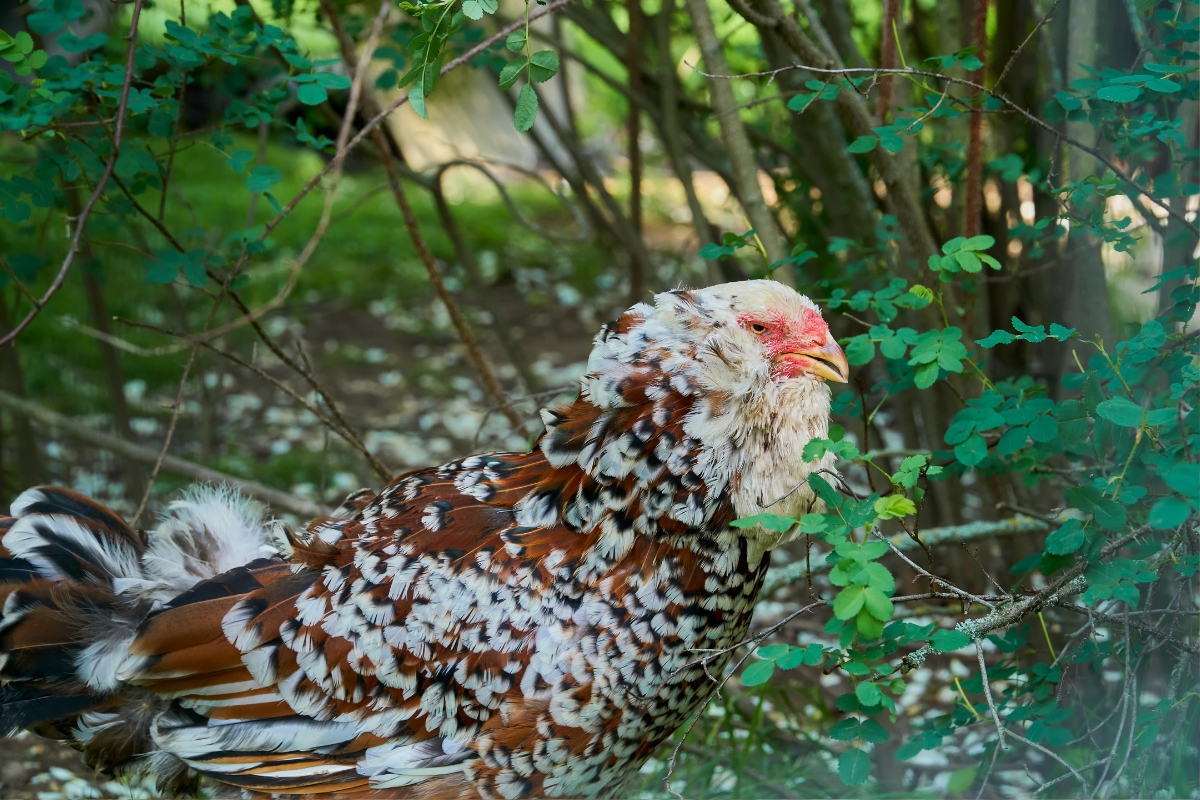
Sussex
The Sussex has long been recognized as one of the best dual-purpose breeds. Other chickens have undergone waves of popularity, but the Sussex remains popular. They reliably lay 200-250 eggs per year, are large enough to produce lots of juicy meat, and are extremely hardy.
A Sussex hen is particularly good at living in cold temperatures, although the large combs of the roosters might need a bit of care in the coldest months. Sussex chickens are very easy to handle, docile, and loving, making them perfect for first-time owners.
- Breed Name: Sussex
- Breed Type: English, dual-purpose (meat and eggs)
- Temperament: Docile, mellow, affectionate
- Size: Hens 7 lbs, roosters 9 lbs
- Eggs Per Year: 200-250
- Egg Size: Medium to large
- Egg Color: Cream, light brown
- Feather Type: Standard, clean legs
- Comb Type: Single
- Hardiness: Cold hardy and heat tolerant
- Lifespan: 8+ years
- Time To Maturity: 20-22 weeks
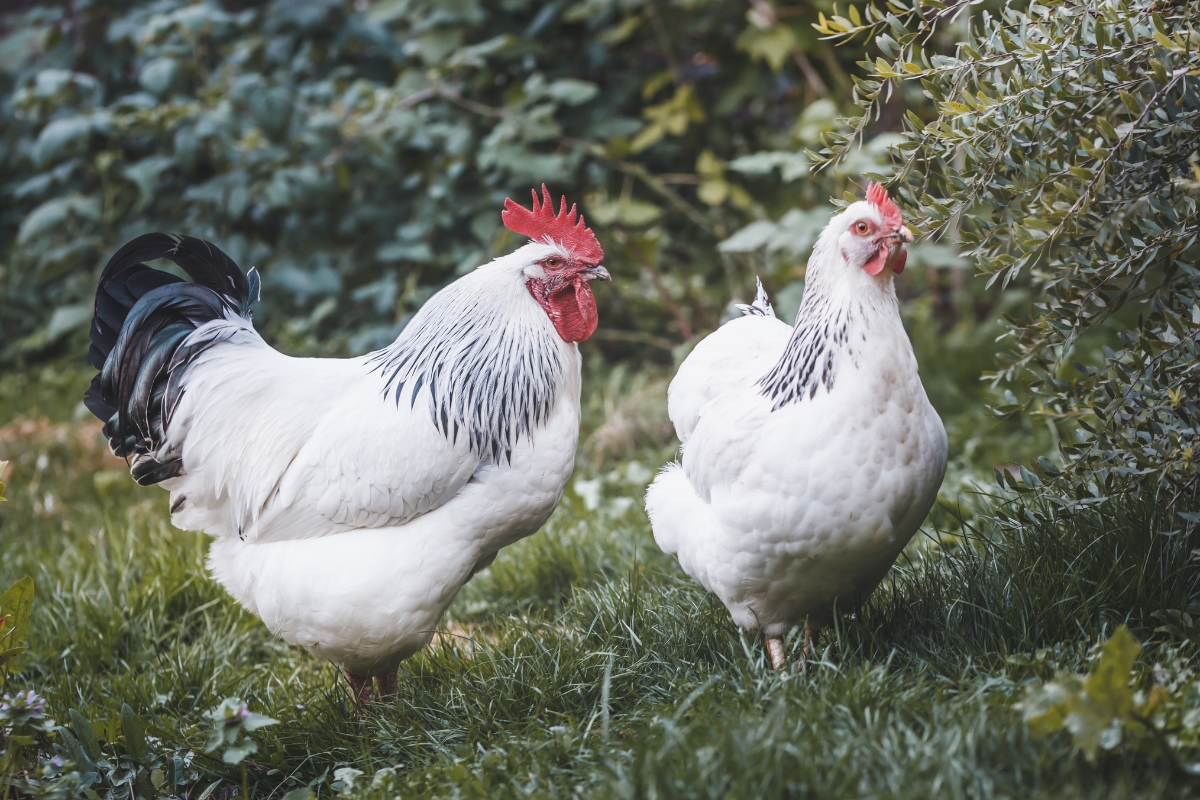
Welsummer
A reliable layer and good table bird, the Welsummer is a hardy breed of chicken that can withstand a range of temperatures. Welsummers originated in the Netherlands, where they were treasured for their dark brown eggs. Sometimes, the egg pigment is so rich that you can wipe it off the shells!
Welsummers are well-suited to the cold, with heavy feathering and large bodies. They’re perfectly friendly, as well, and have so much affection for their owners.
Here’s where you can find my full Welsummer Chicken Breed Guide.
- Breed Name: Welsummer
- Breed Type: Continental, dual-purpose (meat and eggs)
- Temperament: Friendly, docile, calm
- Size: Hens 6 lbs, roosters 8 lbs
- Eggs Per Year: 150-200
- Egg Size: Large
- Egg Color: Dark brown
- Feather Type: Standard, clean legs
- Comb Type: Single
- Hardiness: Cold hardy and heat tolerant
- Lifespan: 6-10 years
- Time To Maturity: 20-24 weeks
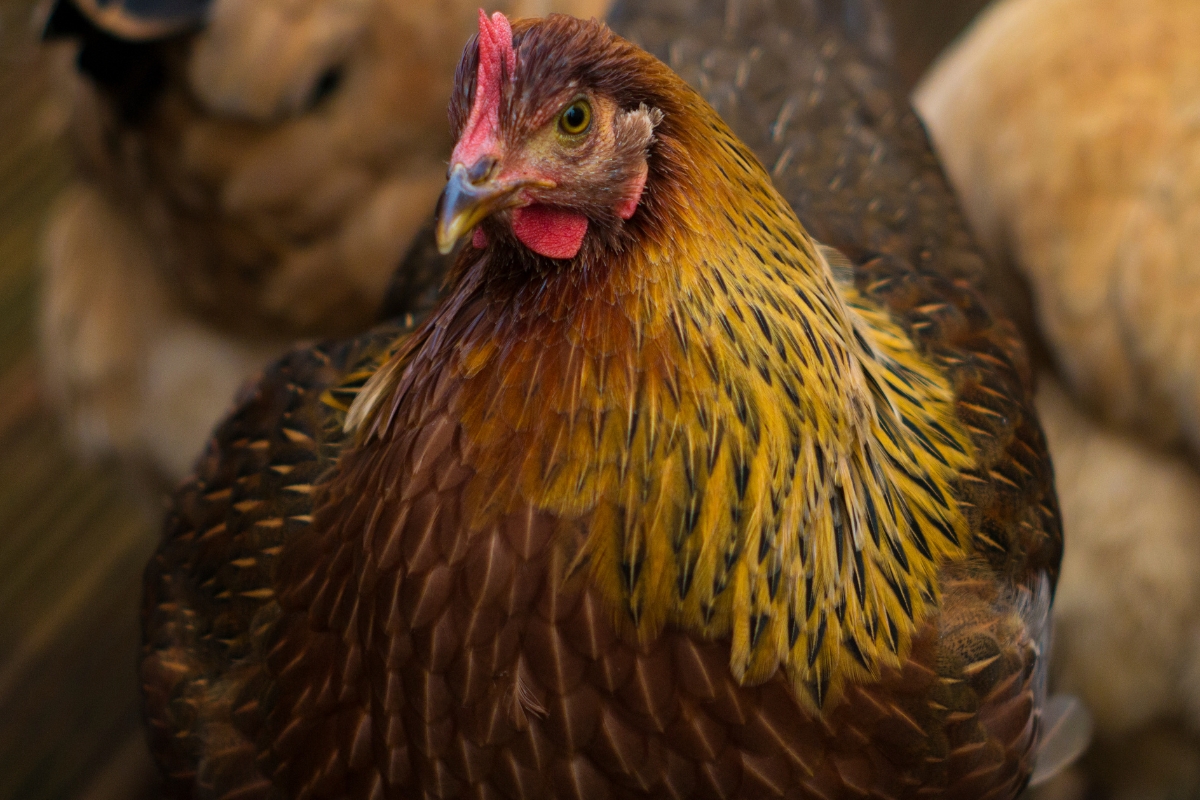
Wyandotte
Among the best cold-hardy chicken breeds is the Wyandotte, a lovely mix of beauty and utility. The Wyandotte was created by American farmers in the 1800s that wanted to create a reliable dual-purpose chicken that could stand the harsh cold of upstate New York. Wyandottes are a pretty heavy breed, between 6-9 pounds, and are covered in dense, warm feathers. These feathers come in a variety of gorgeous patterns and colors, with the silver-laced and golden-laced being the oldest and some of the most popular.
Wyandottes will lay through the winter with sufficient light, so you won’t have to worry about egg production plummeting like other breeds. While they are polite birds, Wyandottes are a bit detached from people, which is perfect if you want an independent breed that can live happily on its own.
- Breed Name: Wyandotte
- Breed Type: American, dual-purpose (meat and eggs)
- Temperament: Aloof, calm, independent
- Size: Hens 6 lbs, roosters 9 lbs
- Eggs Per Year: 200-260
- Egg Size: Medium to large
- Egg Color: Brown
- Feather Type: Standard, clean legs
- Comb Type: Rose
- Hardiness: Cold hardy and heat tolerant
- Lifespan: 6+ years
- Time To Maturity: 20-22 weeks

Chicken Keeping Guides
Looking for more chicken-keeping guides?
- How Much Does it Cost to Keep Chickens?
- Beginner’s Guide to Chicken Egg Colors
- What’s the Difference Between a Duck Egg and a Chicken Egg?
- How to Raise Chickens (Beginner’s Guide)
- How to Raise Baby Chicks into Adult Hens
- 12 Best Egg Laying Chickens for Beginners
